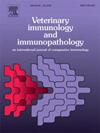一种野毒株匹配二价灭活疫苗在埃及对现代新城疫和传染性支气管炎病毒的比较疗效。
IF 1.4
3区 农林科学
Q4 IMMUNOLOGY
引用次数: 0
摘要
背景:新城疫病毒(NDV)和传染性支气管炎病毒(IBV)每年给全球家禽业造成超过10亿美元的经济损失。在埃及,家禽生产仍然面临主要威胁。新出现的变异菌株日益挑战当前的疫苗接种策略,需要采取更有效的控制措施。方法:我们对一种新型二价灭活疫苗(谷Vac IB3 NDVg7)与一种市售二价疫苗进行了对比,该疫苗含有最新的野地分离株(NDV基因型VII和IBV变种- ii)。选用71日龄商品雏鸡,随机分为7组(n = 10)。1、4、2、5组分别接种新型疫苗和市售疫苗,3、6组为未接种对照组,7组为阴性对照组。接种疫苗后3周,各组分别接种NDV-B7-RLQP-CH-EG-12或IBV-Eg/15170F-SP1/2015。使用标准化方案评估保护率、病毒脱落、纤毛抑制和免疫反应。结果:新型疫苗具有显著的保护作用(90-100 %,P )。结论:采用现代田间毒株的新型二价疫苗可显著增强对当前NDV和IBV变体的保护作用,为改善流行地区的疾病控制提供了一种有希望的策略。这些发现证明了疫苗毒株与流行野地病毒匹配的重要性,并为下一代家禽疫苗的开发提供了框架。本文章由计算机程序翻译,如有差异,请以英文原文为准。
Comparative efficacy of a field-strain matched bivalent inactivated vaccine against contemporary newcastle disease and infectious bronchitis viruses in Egypt
Background
Newcastle disease virus (NDV) and infectious bronchitis virus (IBV) cause annual global economic losses exceeding $1 billion in the poultry industry. In Egypt remain major threats to poultry production. emerging variant strains increasingly challenge current vaccination strategies, necessitating more effective control measures.
Methods
We evaluated a novel bivalent inactivated vaccine (Valley Vac IB3 NDVg7) containing recent field isolates (NDV genotype VII and IBV variant-II) against a commercial bivalent vaccine. Seventy-one-day-old commercial chicks were randomized into seven groups (n = 10). Groups 1,4 and 2,5 received the novel and commercial vaccines respectively, while groups 3,6 served as unvaccinated controls, and group 7 as a negative control. At three weeks post-vaccination, groups were challenged with either NDV-B7-RLQP-CH-EG-12 or IBV-Eg/15170F-SP1/2015. Protection rates, viral shedding, ciliostasis, and immune responses were evaluated using standardized protocols.
Results
The novel vaccine demonstrated significantly superior protection (90–100 %, P < 0.01) compared to the commercial vaccine (60–70 %) against both viruses. Viral shedding in the novel vaccine group was reduced by 2.1 log10 (P < 0.001) by day 5 post-challenge, achieving complete clearance by day 7. Ciliostasis protection scores were significantly higher in the novel vaccine group (87.33–100) versus the commercial vaccine (35–78.33, P < 0.001). Serological responses showed stronger and more sustained antibody titers in the novel vaccine group for both NDV (8.0 ± 2.0 vs 6.7 ± 1.0 log₂, P < 0.01) and IBV (4612.6 ± 839.35 vs 3340.5 ± 1650.16 ELISA units, P < 0.01) through three weeks post-vaccination.
Conclusions
The novel bivalent vaccine incorporating contemporary field strains provided significantly enhanced protection against current NDV and IBV variants, offering a promising strategy for improved disease control in endemic regions. These findings demonstrate the importance of vaccine strain matching with circulating field viruses and provide a framework for next-generation poultry vaccine development.
求助全文
通过发布文献求助,成功后即可免费获取论文全文。
去求助
来源期刊
CiteScore
3.40
自引率
5.60%
发文量
79
审稿时长
70 days
期刊介绍:
The journal reports basic, comparative and clinical immunology as they pertain to the animal species designated here: livestock, poultry, and fish species that are major food animals and companion animals such as cats, dogs, horses and camels, and wildlife species that act as reservoirs for food, companion or human infectious diseases, or as models for human disease.
Rodent models of infectious diseases that are of importance in the animal species indicated above,when the disease requires a level of containment that is not readily available for larger animal experimentation (ABSL3), will be considered. Papers on rabbits, lizards, guinea pigs, badgers, armadillos, elephants, antelope, and buffalo will be reviewed if the research advances our fundamental understanding of immunology, or if they act as a reservoir of infectious disease for the primary animal species designated above, or for humans. Manuscripts employing other species will be reviewed if justified as fitting into the categories above.
The following topics are appropriate: biology of cells and mechanisms of the immune system, immunochemistry, immunodeficiencies, immunodiagnosis, immunogenetics, immunopathology, immunology of infectious disease and tumors, immunoprophylaxis including vaccine development and delivery, immunological aspects of pregnancy including passive immunity, autoimmuity, neuroimmunology, and transplanatation immunology. Manuscripts that describe new genes and development of tools such as monoclonal antibodies are also of interest when part of a larger biological study. Studies employing extracts or constituents (plant extracts, feed additives or microbiome) must be sufficiently defined to be reproduced in other laboratories and also provide evidence for possible mechanisms and not simply show an effect on the immune system.

 求助内容:
求助内容: 应助结果提醒方式:
应助结果提醒方式:


